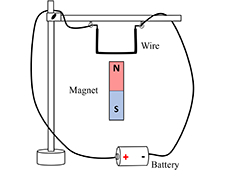
Magnetic interactions
Variant i Dynamics first Other Variants Interactive tutorial lecture
Provides practice using the right-hand rule and in relating: magnetic fields to currents, compass readings to field lines, and top and side view diagrams to the real world.
Topics Electricity and magnetism / Magnetism: fields, superposition, vectors, bar magnet, compass, current-carrying wire, and magnetic fields
Materials
Materials by the UW team
- Group Handout


- Instructor Guide


- Pretest


- Exam Questions



- Equipment List

Tutorial details
Students begin by examining how the orientation of a bar magnet near a current-carrying wire affects a current carrying wire. After making predictions for several different orientations, students perform the designated experiments and resolve any inconsistencies between their predictions and observations. They are led through the reasoning necessary to recognize how thevector equation F = il × B describes the magnetic force on the current-carrying wire. Studentswho have studied magnetic fields of current-carrying wires previously may have difficulty in recognizing that the field of the wire does not contribute to a force on the wire.
In section II, students use magnetic compasses to examine the magnetic field of a current- carrying wire. Some will have difficulty in inferring the direction of the field at a point from the orientation of the compass. They may think they need to locate the north and south poles of the wire in order to determine the field direction. Check their answers to the first question in this section, which tries to help them associate the compass direction with the direction of the field lines at that location.
In section III students extend their results to the case of current loops and solenoids. Exercises guide students to make an analogy between a current loop and a magnet and to predict the behavior of a current-carrying loop in the presence of a bar magnet. Finally students are led to recognize the similarities between the magnetic field of a long solenoid and that of a bar magnet.
As students work through the tutorial, it is important for instructors to check that all the students at a table (not just one or two) are able to apply the relevant right-hand rule. Variations of the questions in the tutorials can serve as a check.
For instruction tips, login or register as a verified educator to see the Instructor Guide.
Prerequisites
Prerequisite tutorials
The Magnets and magnetic fields tutorial is a prerequisite to Magnetic interactions.
Other prerequisites
The tutorial assumes that students have seen F = il × B in lecture or elsewhere. Students are expected to be familiar with the magnetic field of a bar magnet. The tutorial Magnets and magnetic fields covers this topic. No knowledge of the field of a current-carrying wire is assumed.
Equipment
Special Instructions
Each group should be given a copy of the two diagrams in the tutorial handouts.
Additional equipment is also needed to assemble apparatus shown in figure below:
- 6 wooden dowels
- 6 ring stands and clamps
- 12 extra-large paper clips
- 12 alligator clip leads
- 6 pieces of insulated connecting wire (~30-cm in length), formed into a U–shape and with the ends stripped.
- 12 D batteries in 6 two-battery holders

List
- bar magnet
- handouts
- magnetic compass
- white board or large sheet of paper with markers
- wire loop
Coming Soon! We hope to release the discussion section on each tutorial soon.

